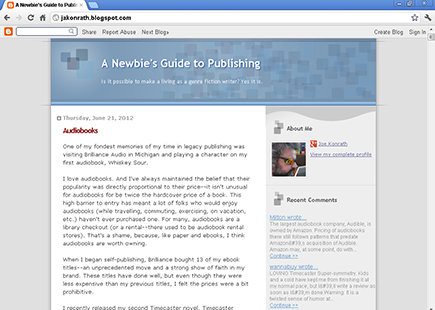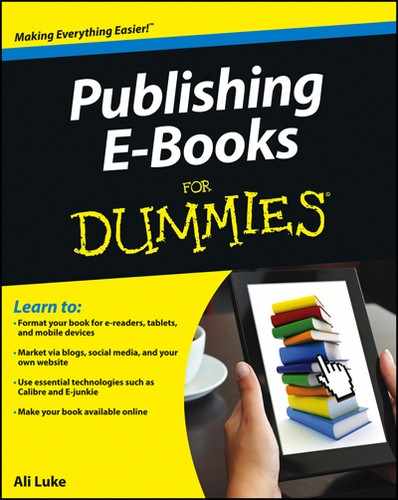Figure 2-1: J.A. Konrath’s blog.
Self-Publishing Case Studies and Success Stories
Plenty of self-publishers are doing quite well for themselves from e-books, by selling hundreds of thousands of copies of them via Amazon (www.amazon.com). No number officially signifies a bestseller, though 10,000 copies is a common rule of thumb.
The authors who succeed in self-publishing have varied backgrounds: Some have had long careers as authors working with traditional publishers, and others started out in self-publishing and quickly found success. What they all have in common is an initial online audience (not necessarily a large audience) and the willingness to experiment.
Following the example of established authors who are embracing self-publishing
Savvy authors are turning away from the traditional publishing world to make more money on their own by self-publishing e-books. Two examples are the genre authors J.A. Konrath, who writes thrillers and crime novels, and Holly Lisle, who writes fantasy and science fiction. Both have published multiple novels via traditional channels, and both have turned to e-books in recent years.
J.A. Konrath’s thriller and crime novels
If you haven’t yet come across J.A. Konrath’s popular and outspoken blog, A Newbie’s Guide to Publishing, give it a look. Figure 2-1 shows the site’s home page, and you can find the site online at http://jakonrath.blogspot.com
.
I find Konrath’s tone acerbic at times, but at least he isn’t afraid to speak his mind — that traditional publishing definitely isn’t in an author’s best interest and that self-publishing is a much better option.

This prolific author has 18 self-published e-books available, plus several more in print with traditional publishers (the Jack Daniels series). In January 2012, he said that he had sold a total of almost 700,000 e-books.
Consider following Konrath’s example in these three key principles:
![]() The more books you can write, the better. If readers buy and love one book you’ve written, they’re likely to go on and buy another, especially if your books are inexpensive. Most of Konrath’s e-books are priced between 99 cents and $2.99.
The more books you can write, the better. If readers buy and love one book you’ve written, they’re likely to go on and buy another, especially if your books are inexpensive. Most of Konrath’s e-books are priced between 99 cents and $2.99.
![]() Have the courage to self-publish. A book that publishers have rejected (such as Konrath’s The List or Origin) may be a hit with readers.
Have the courage to self-publish. A book that publishers have rejected (such as Konrath’s The List or Origin) may be a hit with readers.
![]() Self-publishing can bring in much more money than traditional publishing does. You receive more royalties per copy sold — 70 percent via Amazon rather than the typical 17.5 percent from a publisher. Konrath often emphasizes this point on his blog.
Self-publishing can bring in much more money than traditional publishing does. You receive more royalties per copy sold — 70 percent via Amazon rather than the typical 17.5 percent from a publisher. Konrath often emphasizes this point on his blog.
Holly Lisle’s fantasy and science fiction
Like Konrath, Holly Lisle has an established online fan base and a history of traditional publishing — 32 novels in print from major publishing houses. In 2011, Lisle announced that she would self-publish her fiction, for reasons that are similar to Konrath’s: Dissatisfied with the publishing world, she wants the freedom to sell her books in her own way.
Writers can find lots of useful, free advice on Lisle’s website (www.hollylisle.com
), shown in Figure 2-2. Read her blog (http://hollylisle.com/weblog
) to follow her journey with fiction and nonfiction independent publishing.
Keep Lisle’s example in mind as you follow these key principles:
![]() Making a living from a string of midlist (non-bestselling, but economically viable) novels is difficult, if not impossible. Before Lisle’s recent move into self-publishing fiction e-books, she wrote a number of nonfiction e-books and created self-study e-courses (with text, video and forums) on the craft of writing.
Making a living from a string of midlist (non-bestselling, but economically viable) novels is difficult, if not impossible. Before Lisle’s recent move into self-publishing fiction e-books, she wrote a number of nonfiction e-books and created self-study e-courses (with text, video and forums) on the craft of writing.
![]() Retaining your publishing rights after you’ve sold a book to a traditional publisher can be quite difficult. It’s difficult even if your book is out of print. Lisle has written about her six-month battle to retrieve her rights on her novel Talyn.
Retaining your publishing rights after you’ve sold a book to a traditional publisher can be quite difficult. It’s difficult even if your book is out of print. Lisle has written about her six-month battle to retrieve her rights on her novel Talyn.
Figure 2-2: Holly Lisle’s website.

Site design and contents © Holly Lisle. ALL RIGHTS RESERVED.
Following the lead of new authors who are embracing self-publishing
Though J.A. Konrath and Holly Lisle are authors with decades of experience in traditional publishing, plenty of other, successful e-book authors started out with little or no experience, as described in the following three sections.
Amanda Hocking’s paranormal romances
Amanda Hocking has become something of a poster girl for the world of self-publishing, and you may well have come across her name in the news. Her story is certainly an inspiring one: At the beginning of 2010, Hocking was writing at night while working a low-paid day job. Wanting to raise cash for a trip, she decided to self-publish as e-books her unpublished novels (which then numbered 17).
Hocking uploaded her first e-book to Amazon in April 2010. By January 2011, she was selling more than 100,000 e-books per month. You can find her blog, shown in Figure 2-3, online at www.amandahocking.blogspot.com
.
Like many other self-published authors of trilogies, Hocking often prices the first book of three at 99 cents, to encourage impulse buyers.
This list details helpful advice from Hocking:
![]() Find time for writing, and stay focused on it. Hocking claims to write a novel draft in two to three weeks. This goal isn’t a realistic one for most authors, but writing a thousand words a day means that you finish a draft about every four months.
Find time for writing, and stay focused on it. Hocking claims to write a novel draft in two to three weeks. This goal isn’t a realistic one for most authors, but writing a thousand words a day means that you finish a draft about every four months.
![]() Study other self-publishers to benefit from their advice. Hocking followed Konrath’s blog and followed his tips to help her publish and distribute her books through Smashwords.
Study other self-publishers to benefit from their advice. Hocking followed Konrath’s blog and followed his tips to help her publish and distribute her books through Smashwords.
![]() Remember that your goal is larger than simply self-publishing an e-book. Hocking has now signed a print deal (for a reported $2.1 million) with St. Martin’s Press, stating that she wants to focus only on writing.
Remember that your goal is larger than simply self-publishing an e-book. Hocking has now signed a print deal (for a reported $2.1 million) with St. Martin’s Press, stating that she wants to focus only on writing.
Figure 2-3: Amanda Hocking’s blog.

John Locke’s crime novels and westerns
John Locke originally struggled with self-publishing in print: No store would stock his self-published books, and though he bought advertising, hired a publicist, and distributed press releases, he became frustrated at the amount of money he had invested in a poor result.
After Locke e-published his novels, though, he managed to sell a million of them in only five months, with a strong eye on self-promotion and marketing via blogging and social media, and with bargain-basement prices — many of his e-books are 99 cents. You can find his website, shown in Figure 2-4, at www.donovancreed.com
.
To benefit from Locke’s experience, follow this advice:
![]() One well-crafted blog post that grabs attention is much more valuable than daily posts that no one reads. Locke was selling only 50 e-books per month before writing a blog post that drew 5,000 hits in a day — and sales of his book then snowballed.
One well-crafted blog post that grabs attention is much more valuable than daily posts that no one reads. Locke was selling only 50 e-books per month before writing a blog post that drew 5,000 hits in a day — and sales of his book then snowballed.
![]() Take the time to invest in strong relationships with readers. Locke outlines a strategy for this task using a website, a Twitter account, and e-mail in his e-book for writers, How I Sold 1 Million eBooks in 5 Months!
Take the time to invest in strong relationships with readers. Locke outlines a strategy for this task using a website, a Twitter account, and e-mail in his e-book for writers, How I Sold 1 Million eBooks in 5 Months!
Figure 2-4: John Locke’s website.

![]() Series of genre fiction books draw repeat buyers. Locke has a series of thrillers (the Donovan Creed novels) as well as a Western series (Emmett Love Westerns).
Series of genre fiction books draw repeat buyers. Locke has a series of thrillers (the Donovan Creed novels) as well as a Western series (Emmett Love Westerns).
Darren Rowse’s e-books on blogging and photography
Though Darren Rowse has a published print book (ProBlogger: Secrets for Blogging Your Way to a Six-Figure Income, co-authored with Chris Garrett) and an e-book produced by the established publisher SitePoint (31 Days to Build a Better Blog), he has also self-published a number of e-books on blogging and photography, for his sites www.problogger.net
and www.digital- photography-school.com
.
Consider these suggestions from Rowse:
![]() An established online audience is helpful when marketing e-books. A blog is an excellent way to build up readership, as discussed in Chapter 18.
An established online audience is helpful when marketing e-books. A blog is an excellent way to build up readership, as discussed in Chapter 18.
![]() You can repurpose existing content into an e-book: Rowse’s 31 Days to Build a Better Blog was based on a monthlong series of posts on his blog.
You can repurpose existing content into an e-book: Rowse’s 31 Days to Build a Better Blog was based on a monthlong series of posts on his blog.
![]() You can move between traditional publishing and self-publishing or seek out a collaboration. This statement applies especially if you have a strong online platform and an attractive proposition for a publisher; it isn’t necessarily an either-or choice.
You can move between traditional publishing and self-publishing or seek out a collaboration. This statement applies especially if you have a strong online platform and an attractive proposition for a publisher; it isn’t necessarily an either-or choice.
![]() Don’t go it alone. If you’re short on time, expertise, or inclination, you can bring someone else on board to write or co-write your e-books. Most of the e-books offered by Rowse are written by other people.
Don’t go it alone. If you’re short on time, expertise, or inclination, you can bring someone else on board to write or co-write your e-books. Most of the e-books offered by Rowse are written by other people.
